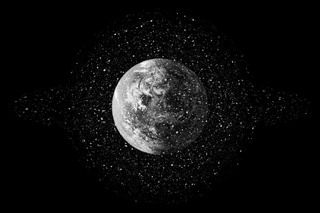
‘Space Is Not a Trash Can,’ Says Scientist About Worsening Debris Problem
“While much is being done to clean up our oceans and our rivers, space debris is the responsibility of all nations who operate there.”

“Space is not just a trash can, folks, it’s really something we have to take care of,” James Head, a professor of Geological Sciences at Brown University in the U.S., told CGTN recently.
Head was referring to the rapidly growing problem of space junk. The World Economic Forum noted that 6,000 satellites are currently circling the Earth — 60% of which are defunct. So, essentially, about 3,600 satellites in space right now are space junk. Research also suggests that close to a thousand satellites will be launched into space every year till 2028 — a four-fold increase from the previous decade. This would, of course, exponentially increase the amount of space debris that they will eventually turn into.
It’s not just old, defunct satellites that constitute space junk. Think old, abandoned rocket bodies floating in the vast expanse, debris from collisions in space, and lastly, random lost items — essentially, any human-made items that have ceased to serve any useful function.
In fact, in 2020, a moon-like object entered the Earth’s orbit, initially leading scientists to speculate whether it could be an asteroid. Eventually, it turnedout to be space junk — a rocket booster from the Cold War-era “space race” between the U.S. and the Soviet Union
“By mid-century, things will progress further. More nations will join the ‘space club,’ more space agencies will send astronauts to space… Commercial entities will establish a permanent presence and will pursue many new kinds of space-related ventures…,” Matthew S. Williams, a professional science writer and a science fiction author from Vancouver, wrote. Williams added that “by 2050, commercial space travel, space tourism, orbital space stations, and lunar habitats are likely to become a reality.”
Recently, experts also pointed out that the Earth could potentially have Saturn‑like rings made up of space junk around it — that’s how big the problem is becoming. “It’s a bit of a wild west out there,” Jonathan McDowell, an astrophysicist at the Harvard-Smithsonian Center for Astrophysics, told The Guardian in November.
Related on The Swaddle:
NASA Sends Baby Squids Into Space for Research
Unfortunately, it’s not simply the aesthetic of “trash” circling our planet that experts are worried about. Space junk — as far away as it can seem — has very real impacts on human beings. There’s simply a cost to littering.
First, as Head pointed out, space junk poses a “safety issue” for individuals working in the low Earth orbit — especially with some of the debris reaching speeds of up to 29,000 kilometers per hour. The individuals at risk, among others, include people aboard the International Space Station and the Tiangong Space Station, which is presently being constructed by China.
“[Space shrapnel] is more devastating than most modern weapons used in war today. When a 3-millimeter fleck of paint hit a space shuttle window, it nearly penetrated all the way through armored glass 5 centimeters thick. NASA has calculated that it would take a piece of debris just 1 centimeter in diameter to penetrate the cabin of a spacecraft. Larger than 10 centimeters and your spacecraft is cactus,” an article by the Australian Academy of Science, explains.
Also, to make matters worse, space junk can reach the earth — endangering the lives of humans and other species of flora and fauna. In fact, space junk has injured people in the past: sailors aboard a Japanese vessel in 1969, and a woman from Oklahoma in 1997.
Donald Kessler, a former NASA scientist, proposed a theory in 1978. He argued the increasing space junk can kickstart a chain reaction, causing more and more objects to collide with one another, creating a greater density of trash in the process. This can reach a point where the Earth’s orbit becomes completely unusable for satellites. If that happens, integral aspects of our modern lifestyles — from GPS to television to scientific advancement — stand to be threatened.
In fact, space junk has already begun jeopardizing space exploration. According to a 2021 study, space junk is causing light pollution in space by reflecting sunlight back to Earth — to the extent that the reflected light is interfering with astronomers’ ability to study space. “This is definitely the time to be concerned about the future of both professional and amateur astronomy,” Gregory Brown, an astronomer at the Royal Observatory in Greenwich, had told The Guardian.
Related on The Swaddle:
A Food App Has Made Its First Delivery in Space
“The space around our planet is filled with rubbish. It’s time to take out the trash!” NASA states on its website. Scientists from around the world appear to be working towards that.
Last January, it was reported that scientists from the Kyoto University in Japan are working to build the world’s first wooden satellites by 2023. Researchers are also exploring options like sending “space whips” into, well, space to knock debris out of the Earth’s orbit. How do they plan to do that? By employing colossal magnets, harpoons, or nets to bring the debris down, and using the Earth’s atmosphere to burn up the debris.
One company is also planning to recycle space debris — instead of capturing it — into rocket fuel. “It’s like developing a gas station in space,” Herve Astier, of Australia’s Neumann Space, told The Guardian. Yet another company — whose direct objective isn’t to reduce space junk but to address the environmental harms caused by rockets — is devising ways to catapult space vehicles out of the Earth’s atmosphere like a slingshot.
As the article on CGTN notes, “While much is being done to clean up our oceans and our rivers, space debris is the responsibility of all nations who operate there.”
Perhaps, that’s the next set of “space goals” to focus on in this decade.
Devrupa Rakshit is an Associate Editor at The Swaddle. She is a lawyer by education, a poet by accident, a painter by shaukh, and autistic by birth. You can find her on Instagram @devruparakshit.
Related


‘Battle of the Sexes’ Between Mother’s and Father’s Genes Starts in the Womb, Finds Study
